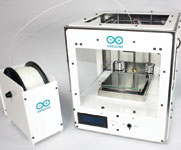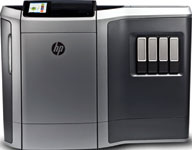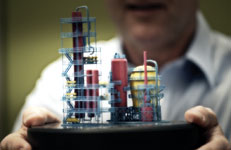
With the 3D printing phenomenon continuing to gain
traction and ever more companies bringing printers to
market catering to a range of pricing and functionality requirements, October saw the launch of two new options that couldn’t possibly be further apart on the spectrum.
Arduino Materia 101

The first is the Materia 101, a completely open source and affordable model from Arduino (better known for its open source embedded computing architecture). Developed in collaboration with Sharebot of Italy, this precision 3D printer runs on Arduino Mega, and is targeted at beginners, makers and educators.
As things stand, it is only available for purchase on the Arduino Store, and comes in kit form or pre-assembled. Pricing at the moment is 570 Euros for the kit, and 696 Euros fully assembled. It is currently open for pre-order with a 30-day delivery time.
The Materia employs fused filament fabrication technology to print volumes up to 140 x 100 x 100 mm. At 310 x 330 x 350 mm in size, the printer weighs 10 kg, uses 65 W of power and features a 20 x 4 LCD display with encoder menu. Fittingly, its intelligence comes via an Arduino Mega 2560 with open source Marlin firmware.
HP Multi Jet Fusion

A vastly different proposition has been unveiled by Hewlett-Packard (HP) in the form of Multi Jet Fusion. The company’s intent to push the boundaries of 3D printing with this technology was made clear at the public launch, during which it was also revealed that the first systems will go on sale in 2016.
While pricing was not even hinted at, it’s safe to assume that it won’t come cheap – at least, not at first. With a mega-corporation like HP entering what is already a rapidly growing and disruptive market, other consumer printer manufacturers may soon feel compelled to follow suit. The economies of scale that these companies can bring to the party will likely speed the market’s arrival at the conceptual end-goal of putting a 3D printer on the desk of the same ‘man in the street’ who currently uses – and can afford – a regular paper printer.
Multi Jet Fusion is built on HP thermal inkjet technology and features a unique synchronous architecture that images entire surface areas (versus one point at a time) and is touted to achieve functional build speeds in excess of 10 times faster than today’s fastest technology. The company also believes that, when considered holistically, its solution will prove to be very economical when factors such as running time, cost, energy consumption and waste are taken into account.
It uses a proprietary multi-agent printing process which HP promises will prove to be a leap forward in accuracy, resiliency and strength, with the ability to deliver fully functional parts with finer details and smooth surfaces, as well as manipulate part and material properties, including form, texture, friction, strength, elasticity, electrical, thermal properties and more.
HP is also working with other companies on advanced materials beyond the current use of thermoplastics, and intends to bring its colour science expertise and the full-colour capabilities of its traditional printers into the third dimension.


Multi Jet Fusion is just one half of HP’s Blended Reality ecosystem, which it says is “designed to break down the barriers between the digital and physical worlds.” The other member of the duo is Sprout, a platform that essentially aims to quite literally add another dimension to computing.
Already available for pre-order in select international markets, Sprout combines a scanner, depth sensor, high-resolution camera and projector into a single device that lets users take physical items and seamlessly merge them into a digital workspace. People in different locations can even collaborate on and manipulate a single piece of digital content in real time.
A supporting app ecosystem is, well, ‘sprouting up’ in the form of the Sprout Marketplace ( www.sprout.com). It currently contains only a small selection of Windows-based first- and third-party applications but HP and its partners are working on expanding the range with creative applications for professionals, families, gamers and others.
© Technews Publishing (Pty) Ltd | All Rights Reserved